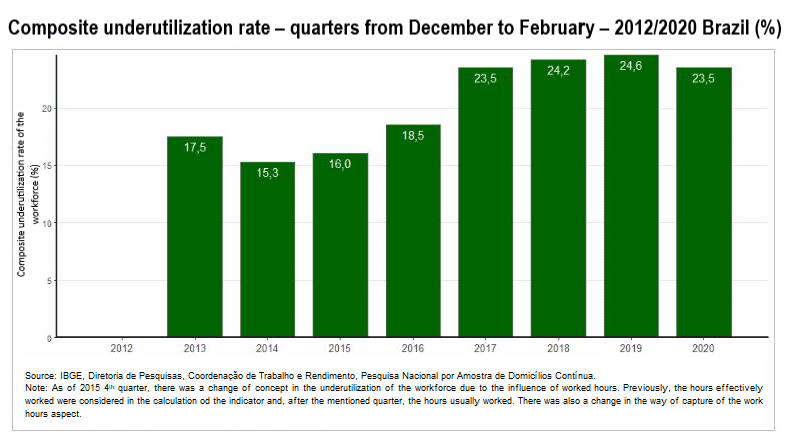Continuous PNAD: unemployment rate is 11.6% and underutilization rate is 23.5% in quarter ended in February 2020
March 31, 2020 09h00 AM | Last Updated: April 22, 2020 12h36 PM
ERRATA: An error was identified in the calculation of the quarterly and annual changes in the real average earnings and in the real wage bill. The absolute values of the estimates have not been altered. The file with the summary tables was corrected and replaced, the changes were corrected in the release and in the news about the Continuous PNAD, published today at the IBGE News Agency.
The unemployment rate (11.6%) rose 0.5 percentage points (p.p.) in the moving quarter ended in February 2020 in relation to the quarter from September to November 2019 (11.2%). and fell 0.8 percentage points over the same quarter a year ago (12.4%).
| Indicator/Period | Dec-Jan-Feb 2020 | Sept-Oct-Nov 2019 | Dec-Jan-Feb 2019 |
|---|---|---|---|
| Unemployement Rate |
11.6% | 11.2% | 12.4% |
| Labor underutilization |
23.5% | 23.3% | 24.6% |
| Usual real earnings |
R$2,375 | R$2.373 | R$2,381 |
| Change of usual earnings in relation to: | 0.1% (stability) | -0.3% (stability) | |
The unemployed population (12.3 million persons) increased 4.0% (479 thousand more persons) compared with the previous moving quarter and -5.4% (711 thousand less persons) in relation to the same quarter last year.
The employed population (93.7 million) had a reduction of 0.7% in relation to the previous quarter (706 thousand less persons). It increased 2.0% (1.8 million more persons) over the same quarter in the previous year.
The informality rate hit 40.6% of the employed population, representing a contingent of 38.0 million informal workers. This rate had been 41.1% in the previous moving quarter and 40.7% in the same quarter last year.
The population out of the workforce (65.9 million persons) reached its highest level in the time series initiated in 2012, with a high of 1.3% (815 thousand more persons) in relation to the previous moving quarter and stability in relation to the same quarter in 2019.
The composite underutilization rate of the workforce (23.5%) held steady in relation to the previous moving quarter (23.3%) and had reduction of -1.1 pp in relation to the same moving quarter last year (24.6%).
The underutilized population (26.8 million persons) was stable against the previous moving quarter (26.6 million) and fell -3.6% (998 thousand less persons) against the same quarter in 2019.
The discouraged population (4.7 million) remained statistically stable in both comparisons, as well as the percentage of the discouraged in relation to the workforce or discouraged population (4.2%).
The category of those employed with a formal contract in the private sector (except for domestic workers), estimated at 33.6 million persons, remained stable in relation to the previous moving quarter and increased 2.0% (646 thousand more persons) compared with the same quarter of 2019.
The category of those employed without a formal contract in the private sector (11.6 million persons) remained stable in relation to the previous moving quarter and increased 5.1% or 569 thousand more persons) compared with the same quarter of 2019.
The number of self-employed workers hit 24.5 million persons and remained stable in relation to the previous moving quarter. It rose 3.2% (more 766 thousand persons) in relation to the same period in 2019.
The average usual real earnings (R$2,375) in the quarter ended in February remained stable in both comparisons.
The average usual real wage bill (R$217.6 billion) held steady against the previous quarter and grew 1.9% (or R$1.9 billion) over the same quarter in 2019.
As to the groups of activities, in relation to the previous moving quarter, there were decreases in: Construction (-4.4% or 301thousand less persons), Public administration, defense, social security, education, human health and social services (-2.3%, or 375 thousand less persons) and Domestic services (-2.4% or 156 thousand less perosns). The other groups did not record any significant changes.
In relation to the same moving quarter of 2019, employment increased in three activity groups: General industry (5.0% or 578 thousand more persons) and Other services (4.8% or 235 thousand more persons). The other groups did not show any significant changes.
The employment-population ratio – percentage of employed persons at working age – was estimated at 54.5%, with reduction of 0.6 percentage points over the previous mvong quarter (55.1%) and a high of 0.6 percentage points over the same quarter of 2019.
Estimated at 106.1 million persons, the workforce – employed and unemployed persons – remained stable in relation to the previous moving quarter and grew 1.1% (1.1 million more persons) against the same quarter of 2019. The potential workforce (8.0 million persons) remained stable in both comparisons.

The number of time-related underemployed persons (6.5 million) retreated (-6.7% or 463 thousand less persons) against the previous moving quarter and remained stable against the same quarter of 2019.
The category of the employers (4.4 million persons) remained stable in relation to the previous moving quarter and also to the same quarter of 2019.
The categories of civil servants (11.4 million persons), which includes statutory and military workers, had decrease of 2.7% (316 thousand less persons) over the previous quarter and stability in comparison with the same quarter a year ago.


